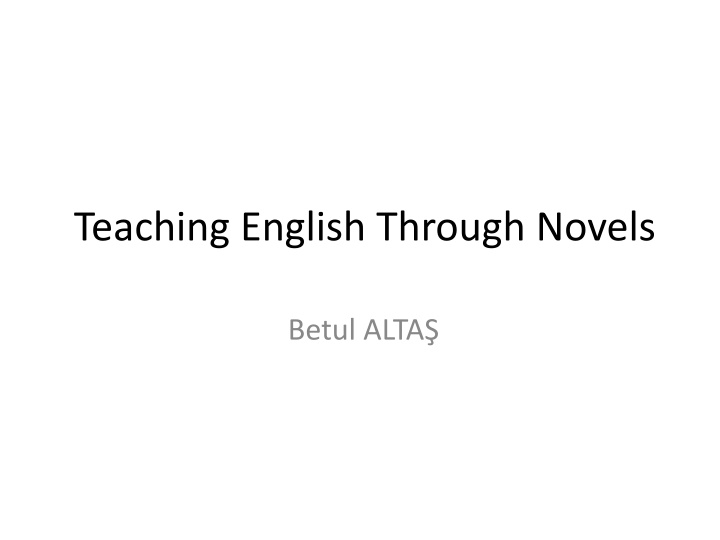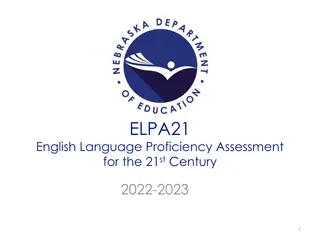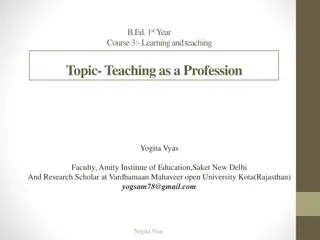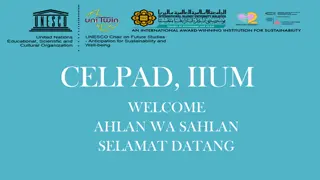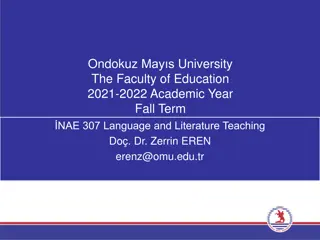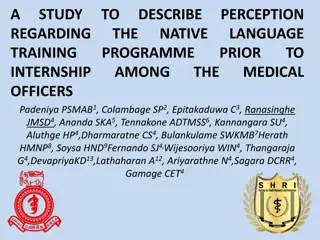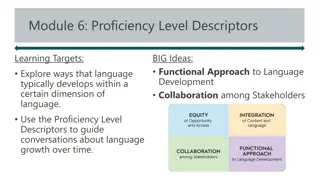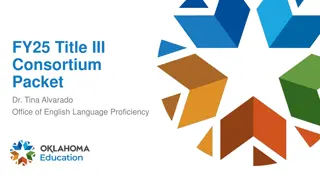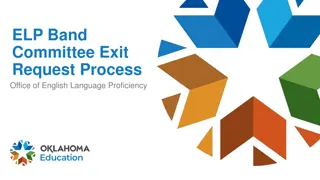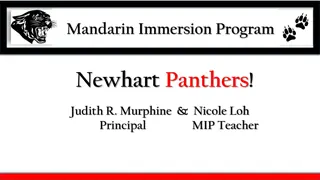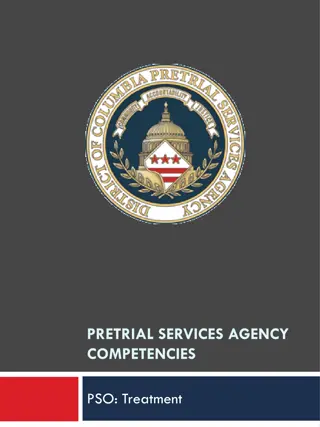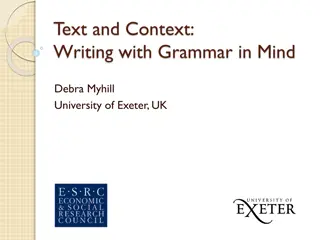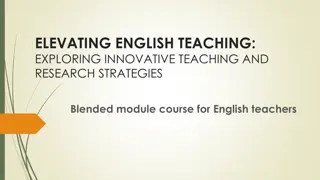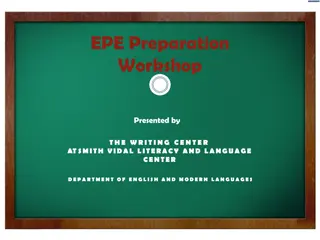Exploring the Role of Novels in Teaching English Proficiency
Utilizing novels in English language teaching offers authentic and engaging cultural material, enhancing linguistic and communicative skills development. The shift towards cognitive methodologies has highlighted the significance of literature in creating meaningful learning contexts. Despite challenges, incorporating novels can empower learners to acquire native-like competence and express ideas effectively.
Download Presentation

Please find below an Image/Link to download the presentation.
The content on the website is provided AS IS for your information and personal use only. It may not be sold, licensed, or shared on other websites without obtaining consent from the author.If you encounter any issues during the download, it is possible that the publisher has removed the file from their server.
You are allowed to download the files provided on this website for personal or commercial use, subject to the condition that they are used lawfully. All files are the property of their respective owners.
The content on the website is provided AS IS for your information and personal use only. It may not be sold, licensed, or shared on other websites without obtaining consent from the author.
E N D
Presentation Transcript
Teaching English Through Novels Betul ALTA
Use of literature plays an important role in EFL/ESL classrooms: authentic pleasurable cultural material (Hall, 2005)
Literature has a powerful role in teaching the four skills. It enables the development of linguistic and communicative skills.
The reason for the interest in the use of literature in EFL/ESL The rising popularity of cognitive approach overthrew the dominance of behavioristic approach. Then, it formed the basis of communicative methodology in language learning.
Use of literature Meaningful rather than mechanical practice. In comparison to mechanical nature of market driven course books, use of literary texts offers a more realistic learning context
Referential language (mainly informational) a mechanical framework. Representational nature of literary texts stimulation of emotions along with cognitive faculties (McRae, 1994).
According to Obediat (1997), literature enables learners: to acquire a native-like competence to find a platform to voice their ideas to be familiar with the idiomatic expressions to be familiar with modern English to be critical, analytical and creative
All of the sources, teaching English through novels is probably one of the most challenging. It can be difficult to integrate the novel into curriculum. Some teachers believe that it can be time/energy consuming to use novels based on the outcome.
Discussion questions 1. How does the use of novels contribute to the proficiency level of students? 2. Does the use of novels provide learners with a meaningful context in language learning?
Benefits of teaching English through novels Implicit meaning provided with literary text invites learners to go beyond the text cultural knowledge language enrichment sensitivity to language inferential understanding perception of social status
Use of novels in EFL/ESL classrooms stimulates students imagination/creativity enables learners to identify the emotions of the characters enables learners to master skills (Helton, Asamani & Thomas, 1998).
empowers oral and written skills presents a unique way of reading motivates learners to become a lifelong learners stimulates learners critical thinking abilities
reflects the importance of sociolinguistic aspect of target language (sociolects, regional dialects, jargon, idiolects and so on) develops learners sociolinguistic competence helps learners to be exposed to the ways of target culture (Helton, Asamani & Thomas, 1998).
Literary texts are representational (MacRae, 1994). Function of representational language in novels is more elaborate than referential language. It involves emotions, imagination and creativity as well as the use of cognitive skills.
The use of novels improves learners four language skills. The study of the conversational discourse through novel aims to contribute to speaking skills which will be reinforced by activities such as: classroom discussions role-playing dramatization improvisation
Difficulties and risks of teaching English through novels Before 1970s, language teaching was dominated by structural methods. Using literary texts was perceived as useless The main argument was that use of literature was challenging in terms of: linguistic cultural difficulties
Most common arguments against the use of literature in EFL/ESL setting Primary purpose of teachers is to teach grammar (McKay, 1982). Studying literature will not enable learners to fulfill their academic/occupational objectives. Specific cultural views embedded in literary text will make the language learning process harder (McKay, 1982)
Another argument Students with low proficiency level may have difficulty in understanding the literary elements such as: allusions ironies metaphors
Some examples * Allusion eg: Don t act like Romeo before her. * Ironies eg: My grave is like to be my wedding bed. * Metaphor eg: she is all states, and all princes, I.
What we need to take into consideration while selecting literary texts Grammatical Lexical Syntactical Needs Interests Expectations Age Gender Culture (cultural content and appropriateness) Lenght of the text
How to eliminate the problems of linguistic and cultural complexity Using simplified texts Using more comprehensible texts Using young adult texts
How to use a novel Classification of reading activities proposed by Lazar (1993) is listed as follows: pre-reading while-reading post-reading
Pre-reading Activities (a warm-up stage) Guessing the subject matter of the story, based on pictures Classroom discussions, regarding the title/first paragraph of the novel Assigning mini-projects to groups (such as poster, essay, a talk)
While-reading activities The main focus is generally on reading and writing skills. Comprehension check questions Asking a concise summary of the novel/story. Providing learners with jumbled sentences and asking them to re-order them. Sentence completion activities which enables them to make cause-effect relationship.
Post-Reading stage Listening Speaking Reading Writing integrated manner
What we need to take into consideration while choosing a novel Proficiency level Age Gender Interest Course objectives Suitability of content
Themes L1 culture L2 culture Availability of time Literary background of the learners (Note: These factors may serve as a checklist)
How to determine the range of vocabulary The average number of vocabulary items is generally between 250-300 words per page (Nation, 2001). The number of unknown vocabulary items allowed per page is 5 or 6.
The other way to determine the amount of new vocabulary items is to use: Krashen s i+1 input hypothesis
Creating a timeline Length of novel Proficiency level of students Course objectives Activities and tasks (A novel can be used for time periods which range from a couple weeks to a full term study.)
Grammar 1- Close reading word choice sentence construction punctuation 2- Transformation Drills active to passive 3- Cloze exercises finding out missing words
4- Recognition of specific grammatical patterns 5- Identifying sentence/clause types Vocabulary 1. Guessing the meaning of unfamiliar vocabulary 2. Determining vocabulary meaning using : contextual clues reference sources prefixes and suffixes using Latin and Greek roots
Reading List of strategies used to improve reading skills of students: Skimming a text for the main ideas Scanning a text for the specific details Drawing conclusions
Making inferences Predicting Sequencing, identification of the components of a story Previewing a text for an idea of what the text is about without reading the main body. Establishing a purpose for reading Adjusting purposes for reading Adjusting reading rate based on purpose of reading
Listening Students acquire a great deal of language by listening to recorded material (Lazar, 1993). Most Common listening activities are: * Listening for the main idea * Note taking * Summarizing the passage * Predicting content * Listening for specific information * Retelling the passage
Speaking Role-playing Discussion Oral reading Dramatization Improvisation Presentations
Writing Writing the end of a novel (from characters point of view) Reconstructing a specific set of events based on a different scenario
Writing activies used in the EFL/ESL classroom 1. Controlled writing : intended level: beginner/elementary level focus is on grammatical structures and correct use of language patterns discussions/debates group/individual brainstoming Clustering
Conference Generating wh questions related to target topic Role-plays 2. Guided Writing intended level: intermediate level focus is on planning,organization content
Independent learning Use of a shared approach Acronyms Templates Writing frames reminders of different text structures outline for a piece of writing outline of a planned text 3. Reproduced Model: Paraphrasing Summarizing Adaptation
